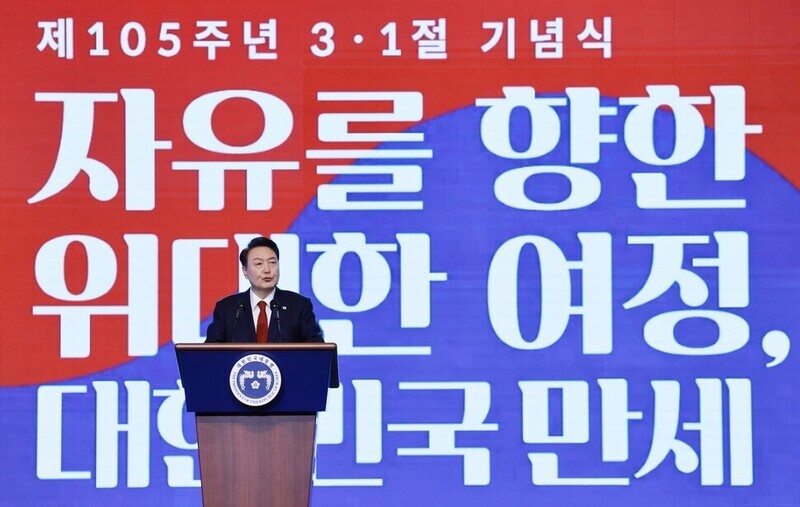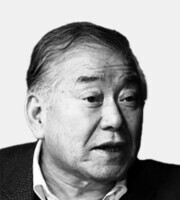hankyoreh
Links to other country sites 다른 나라 사이트 링크
[Column] When freedom is prioritized over peace in Korean reunification


By Moon Chung-in, James Laney Distinguished Professor at Yonsei University
Two hot topics of late among Korea watchers both here and abroad are whether North Korean leader Kim Jong-un has reached a strategic decision about going to war with South Korea and what is signified by his narrative about South and North being two separate states. Regarding the former question, a consensus is forming that an undesired military clash might lead to escalation, but that North Korea is unlikely to plan and execute an all-out war. But as for the second question, academics are divided about whether Kim’s “two states” narrative represents an aggressive tactical response, or a defensive structural transition.
In my view, Pyongyang’s recent actions indicate that a structural transition is underway. Traditionally, North Korea’s unification policy has rested on two pillars. The first pillar was the proposal for a low-level federation — a federation characterized by one people and one state, but two regional governments and two systems. The second pillar was a “united front” strategy that sought to bring about a “revolution of democracy and national liberation on a national scale” that would obviously include South Korea.
A particularly serious threat for South Korea was North Korea’s united front strategy (or stratagem) for strengthening revolutionary capacity in three areas (North Korea, South Korea and the international community) so as to build an underground party organization inside South Korea that could eventually pull off a communist revolution. That’s why even progressive administrations in South Korea have found themselves unable to scrap the National Security Act.
In a plenary session of the Central Committee of the Workers’ Party of Korea (WPK) at the end of 2023, Kim Jong-un defined inter-Korean relations as “the relations between two states hostile to each other.”
Then during a session of the Supreme People’s Assembly on Jan. 15, Kim went on to say that North Korea should “completely eliminate such concepts as ‘reunification,’ ‘reconciliation’ and ‘fellow countrymen’ from the national history of our Republic.”
Kim’s remarks signified both the total repudiation of the “special interim relationship stemming from the process toward reunification” to which South and North Korea had agreed in the Inter-Korean Basic Agreement and the complete rejection of the plan for reunification through a federation based on the idea of “one Korea,” which had been advocated by Kim’s father and grandfather. That erodes the deference to the will of deceased leaders that has been one of the main characteristics of the North Korean system of government.
North Korea had foreshadowed a shift in its united front strategy when it deleted a phrase about “a democratic revolution for the national liberation of the Korean people” from the WPK rules during the Eighth WPK Congress in 2021. And now North Korea has basically decided to chuck the whole idea.
The North Korean government has shuttered a large number of organizations that had specialized in South Korean affairs, including the Committee for the Peaceful Reunification of the Fatherland and the Consultative Council for National Reconciliation, as it prepares to officially close the United Front Department, which has been a key department in the WPK. The North has also ended operations at Uriminzokkiri, a propaganda website, and the Pyongyang Broadcasting System, a state-run radio broadcaster, both of which had targeted audiences in South Korea.
Even more shockingly, the North Korean regime ordered the demolition of the Monument to the Three-Point Charter for National Reunification (better known as the Arch of Reunification), describing it as an “eyesore.” The monument, on Unification Street in the Rangrang District of Pyongyang, had long been prized by North Korean leadership.
That spells the total dismantlement of the united front strategy and a shift of Copernican proportions.
Kim Jong-un provided the following explanation for this shift: “I think it is a mistake we should no longer make to regard the clan, who publicly defined us as the ‘principal enemy’ and is seeking only the opportunity of ‘collapse of power’ and ‘unification by absorption’ in collusion with foreign forces, as the partner of reconciliation and reunification. [. . .] It is not suitable to the prestige and position of [North Korea] to discuss the issue of reunification with the strange clan [that] is no more than a colonial stooge of the US.”
First of all, this shift could be the result of Kim Jong-un’s ruling philosophy of “our state first.” But on a more fundamental level, it can be seen as a preemptive defense against the threat that South Korea poses to the North Korean system.
It also sends the following message: Since North Korea no longer means to threaten the South Korean system with its united front strategy, South Korea should also stop harping on the territorial provision in Article 3 of its Constitution and refrain from threatening Pyongyang or meddling in its internal affairs in line with international norms and international law.
When scrutinized carefully, however, there is no reason to conclude that these changes are necessarily negative for South Korea.
South Korea’s unification policy has always been grounded in the “two state” model. Seoul’s proposed confederation of states was modeled on the EU and based on the principle of one nation in two states and under two systems and two governments. While South Korea prefers a unified state for the Korean people to be based on liberal democracy, it has proposed that the ultimate nature of reunification be decided through a national referendum with the agreement of both South and North.
In light of that, Pyongyang’s “two states” narrative can paradoxically be seen as approximating South Korea’s basic position. The tricky part is how to move “the relations between two states hostile to each other” toward an amicable and friendly relationship that would set the ball rolling toward a peaceful reunification by consensus.
That’s a tall order, to be sure.
“The tyranny and human rights abuses of the North Korean regime deny the universal values of humanity. Unification is precisely what is needed to expand the universal values of freedom and human rights,” Yoon declared in a message on this year’s March 1 Independence Movement Day.
Yoon’s speech amounted to an official endorsement of the idea that reunification represents the “northward march of freedom.” South Korea’s Ministry of Unification has also taken concrete steps to establish a liberal narrative on reunification.
But what future would be brought by a unification policy that places “freedom” before “peace”? Will that help us to prevent war or devastation? Will it keep Korea’s division from being further entrenched?
I can’t help but picture Don Quixote leveling the lance of liberty as he charges the windmills of La Mancha.
Please direct questions or comments to [english@hani.co.kr]

Editorial・opinion
![[Column] Season 2 of special prosecutor probe may be coming to Korea soon [Column] Season 2 of special prosecutor probe may be coming to Korea soon](https://flexible.img.hani.co.kr/flexible/normal/500/300/imgdb/original/2024/0426/3317141030699447.jpg) [Column] Season 2 of special prosecutor probe may be coming to Korea soon
[Column] Season 2 of special prosecutor probe may be coming to Korea soon![[Column] Park Geun-hye déjà vu in Yoon Suk-yeol [Column] Park Geun-hye déjà vu in Yoon Suk-yeol](https://flexible.img.hani.co.kr/flexible/normal/500/300/imgdb/original/2024/0424/651713945113788.jpg) [Column] Park Geun-hye déjà vu in Yoon Suk-yeol
[Column] Park Geun-hye déjà vu in Yoon Suk-yeol- [Editorial] New weight of N. Korea’s nuclear threats makes dialogue all the more urgent
- [Guest essay] The real reason Korea’s new right wants to dub Rhee a founding father
- [Column] ‘Choson’: Is it time we start referring to N. Korea in its own terms?
- [Editorial] Japan’s rewriting of history with Korea has gone too far
- [Column] The president’s questionable capacity for dialogue
- [Column] Are chaebol firms just pizza pies for families to divvy up as they please?
- [Column] Has Korea, too, crossed the Rubicon on China?
- [Correspondent’s column] In Japan’s alliance with US, echoes of its past alliances with UK
Most viewed articles
- 1‘We must say no’: Seoul defense chief on Korean, USFK involvement in hypothetical Taiwan crisis
- 2Is Japan about to snatch control of Line messenger from Korea’s Naver?
- 3[Editorial] Korea’s surprise Q1 growth requires objective assessment, not blind fanfare
- 4Division commander ordered troops to enter raging flood waters before Marine died, survivor says
- 5No good, very bad game for Korea puts it out of Olympics for first time since 1988
- 6Korea’s 1.3% growth in Q1 signals ‘textbook’ return to growth, says government
- 7[Reportage] On US campuses, student risk arrest as they call for divestment from Israel
- 8N. Korean delegation’s trip to Iran shows how Pyongyang is leveraging ties with Moscow
- 9Flying “new right” flag, Korea’s Yoon Suk-yeol charges toward ideological rule
- 10[Column] Park Geun-hye déjà vu in Yoon Suk-yeol